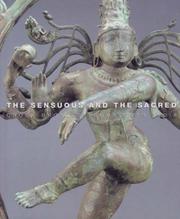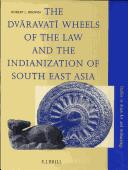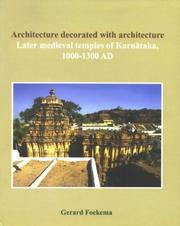| Listing 1 - 10 of 13 | << page >> |
Sort by
|
Book
ISBN: 8175262591 Year: 2005 Publisher: Amdavad Swaminarayan Aksharpith
Abstract | Keywords | Export | Availability | Bookmark
 Loading...
Loading...Choose an application
- Reference Manager
- EndNote
- RefWorks (Direct export to RefWorks)
Bhagwan Swaminarayan --- yogis --- divine leadership --- disciples --- ascetics --- shastras --- bhakti --- mandirs --- philosophy --- devotion
Book
ISBN: 9789004186170 9004186174 9786612952890 9004190112 1282952897 9789004190115 661295289X Year: 2010 Publisher: Leiden Boston Brill
Abstract | Keywords | Export | Availability | Bookmark
 Loading...
Loading...Choose an application
- Reference Manager
- EndNote
- RefWorks (Direct export to RefWorks)
In Pakistan's northwest, a sequence of temples built between the sixth and the tenth centuries provides a missing chapter in the evolution of the Hindu temple in South Asia. Combining some elements from Buddhist architecture in Gandharā with the symbolically powerful curvilinear Nāgara tower formulated in the early post-Gupta period, this group stands as an independent school of that pan-Indic form, offering new evidence for its creation and original variations in the four centuries of its existence. Drawing on recent archaeology undertaken by the Pakistan Heritage Society as well as scholarship from the Encyclopaedia of Indian Temple Architecture project, this volume finally allows the Salt Range and Indus temples to be integrated with the greater South Asian tradition.
Hindu architecture --- Hindu temples --- salt range region pakistan --- Mandiras --- Mandirs --- Temples, Hindu --- Hinduism --- Temples --- Architecture, Hindu --- Religious architecture


ISBN: 0295982845 Year: 2002
Abstract | Keywords | Export | Availability | Bookmark
 Loading...
Loading...Choose an application
- Reference Manager
- EndNote
- RefWorks (Direct export to RefWorks)
Exhibitions --- Chola --- bronzes [visual works] --- Tamil Nadu --- Bronze sculpture, Indic --- Hindu sculpture --- Hindu temples --- Sculpture, Chola --- Chola sculpture --- Mandiras --- Mandirs --- Temples, Hindu --- Hinduism --- Temples --- Sculpture, Hindu --- Sculpture --- Indic bronze sculpture --- Sculpture [Chola ] --- India [South ] --- Sculpture [Hindu ] --- Temples [Hindu ] --- Hindu art
Book
ISBN: 9791036549922 8184701985 9788184701982 9782855391373 2855391377 Year: 2014 Publisher: Pondichéry: Institut français de Pondichéry,
Abstract | Keywords | Export | Availability | Bookmark
 Loading...
Loading...Choose an application
- Reference Manager
- EndNote
- RefWorks (Direct export to RefWorks)
Élevé entre la fin du ixe et la première moitié du xe siècle au cœur du delta de la Kāvēri du pays tamoul, en l’honneur du « grand dieu de Tirukkaṭaimuṭi », le temple shivaïte de Tirucceṉṉampūṇṭi constitue l’assise de cet ouvrage. Maintenant abandonné, ce temple est l’un des exemples les plus anciens d’un art dit Cōḻa. L’analyse conduit à proposer qu’il fut construit en l’honneur d’une des divinités shivaïtes chantées dans l’anthologie poétique des premiers hymnes à Śiva du pays tamoul, le Tēvāram (VIIe-IXe siècles). La difficulté à cerner l’identité du plus important des patrons du temple, la reine Pallava Māṟampāvai, répond à la complexité d’un site où s’entrelacent différents corpus, poèmes, épigraphes, sculptures, monuments Pallava et manifestations artistiques de la période cōḻa. Tirucceṉṉampūṇṭi est ainsi exploré à travers trois directions de recherche principales : il s’agit de définir l’art Cōḻa en reconnaissant la contribution des temples royaux des Pallava et en s’interrogeant sur l’usage des labels dynastiques, d’explorer la relation entre le monde des textes et celui de l’archéologie à l’aide de deux corpus précis, l’un iconographique, l’autre épigraphique et, enfin, d’examiner la relation entre royal et local pour ce qui concerne le phénomène religieux connu sous le nom de "Bhakti". Femme active dans une région déterminée, se proclamant dans des inscriptions tamoules membre d’une famille des Pallava fameuse pour son épigraphie sanskrite, liée à une communauté de marchands plus qu’aux brahmanes, Māṟampāvai paraît cristalliser les rencontres entre plusieurs mondes. L’univers divin n’est pas le moins complexe d’entre eux : Viṣṇu The heart of this book is a temple built in the Tamil-speaking South in the late 9th or early 10th century CE, at Tirucceṉṉampūṇṭi, near Trichy. Now abandoned, that temple is one of the earliest known Śaiva temples of the Cōḻa period. The evidence gathered here suggests that this shrine, dedicated to Śiva as "the great god of…
Temples, Saivite --- Hindu temples --- Inscriptions --- Epigraphs (Inscriptions) --- Epigraphy --- Inscription --- Paleography --- Epigraphists --- Mandiras --- Mandirs --- Temples, Hindu --- Hinduism --- Temples --- Śaivite temples --- Saivism --- Pallava --- bhakti --- temple --- Hindu art --- Tamil epigraphy --- deity

ISBN: 9004071733 9004071741 9004071776 900464654X 9004646523 Year: 1985 Volume: 12 Publisher: Leiden Brill
Abstract | Keywords | Export | Availability | Bookmark
 Loading...
Loading...Choose an application
- Reference Manager
- EndNote
- RefWorks (Direct export to RefWorks)
Hindu sculpture --- Sculpture, Indic --- Gods, Hindu, in art --- Hindu temples --- Temples --- Sculpture hindoue --- Sculpture de l'Inde --- Dieux hindous dans l'art --- Temples hindous --- Hindu gods in art. --- Hindu gods in art --- Architecture --- Church architecture --- Religious institutions --- Mandiras --- Mandirs --- Temples, Hindu --- Hinduism --- Sculpture, Hindu --- Sculpture --- Temples hindous. Orissa (Etat). --- Tempels (Hindoe-). Orissa (Staat). --- Hindu art --- Indic sculpture --- Religious architecture --- Sculpture, Indic.

ISBN: 8121510899 Year: 2003 Publisher: New Delhi Munshiram Manoharlal Publishers Pvt Ltd
Abstract | Keywords | Export | Availability | Bookmark
 Loading...
Loading...Choose an application
- Reference Manager
- EndNote
- RefWorks (Direct export to RefWorks)
Decoration and ornament, Architectural --- Hindu architecture --- Hindu temples --- Mandiras --- Mandirs --- Temples, Hindu --- Hinduism --- Temples --- Architecture, Hindu --- Religious architecture --- Architectural decoration and ornament --- Architecture --- Stonework, Decorative --- Architectural design --- Exterior walls --- Decoration and ornament --- Karnataka (India) --- Карнатака (India) --- Estat de Karnataka (India) --- Καρνάτακα (India) --- Karnatako (India) --- קרנאטקה (India) --- Ḳarnaṭaḳah (India) --- Carnatica (India) --- Карнотако (India) --- Karnotako (India) --- Mysore (India : State) --- Buildings, structures, etc.
Book
ISBN: 9814379859 9814379840 Year: 2012 Publisher: Singapore : Institute of Southeast Asian Studies,
Abstract | Keywords | Export | Availability | Bookmark
 Loading...
Loading...Choose an application
- Reference Manager
- EndNote
- RefWorks (Direct export to RefWorks)
In conveying his condolences to VR Nathan's wife, Prime Minister Lee Hsien Loong said that "as chairman of Hindu Endowments Board, VR Nathan had served the Indian community with distinction and unwavering commitment". Lee also said that VR "had done much for inter-religious harmony in Singapore". Soon after, Zainul Abidin Rasheed, then Senior Minister of State for Foreign Affairs, said in Parliament that he was "very amazed" when he saw at VR's funeral leaders of different faiths paying their last respects and offering prayers. That perhaps is the ultimate tribute any Singaporean of faith could hope for. This is the story of what made an unemployed immigrant from India with little education transform into an ideal Singaporean - successful in his career, yet caring for fellow citizens.
Bankers --- Community activists --- Endowments --- Hindu temples --- Hinduism --- Religions --- Brahmanism --- Mandiras --- Mandirs --- Temples, Hindu --- Temples --- Charitable foundations --- Charitable trusts --- Donations --- Educational endowments --- Endowed charities --- Foundations (Endowments) --- Philanthropy --- Private foundations --- School endowments --- Education and state --- Charities --- Political activists --- Bank officers --- Capitalists and financiers --- Officials and employees. --- Management. --- Nathan, V. R.
Book
ISBN: 0520296338 0520968883 9780520968882 9780520296336 Year: 2018 Publisher: University of California Press
Abstract | Keywords | Export | Availability | Bookmark
 Loading...
Loading...Choose an application
- Reference Manager
- EndNote
- RefWorks (Direct export to RefWorks)
"The Hegemony of Heritage makes an original and significant contribution to our understanding of how architectural objects and societies' relationship to the built environment change over time. Using the pairing of two living medieval monuments in Southern Rajasthan--the Ambika Temple in Jagat, Rajasthan, and the Ékalingji Temple Complex in Kailaspuri--the author underscores many aspects of practice and avoids focusing simply on their divergent sectarian affiliations or patronage structures. This book offers new and extremely valuable questions about these important monuments, such as the entangled politics of antiquity and whether a monument's ritual record is affirmed as continuous and hence hoary, or dismissed as discontinuous or reinvented through various strategies. The Hegemony of Heritage engages theoretical constructs with the richness of ethnographic description and asks us to rethink notions such as archive and text through the filter of sculpture and mantra."--Provided by publisher.
Hindu sculpture --- Hindu architecture --- Hindu temples --- Mandiras --- Mandirs --- Temples, Hindu --- Hinduism --- Temples --- Architecture, Hindu --- Religious architecture --- Sculpture, Hindu --- Hindu art --- Sculpture --- ambika temple. --- antiquity. --- architecture. --- archive. --- asian history. --- common practice. --- eklingji temple. --- entangled politics. --- environment. --- ethnographic description. --- history of hinduism. --- important monuments. --- india history. --- jagat. --- kailashpuri. --- mantra. --- medieval. --- monuments. --- patronage structures. --- rajasthan. --- rituals. --- sculpture. --- sectarian affiliations. --- societies. --- theoretical constructs.
Book
ISBN: 2855394163 9782855394169 Year: 1987 Volume: 16 Publisher: Paris: École française d'Extrême-Orient,
Abstract | Keywords | Export | Availability | Bookmark
 Loading...
Loading...Choose an application
- Reference Manager
- EndNote
- RefWorks (Direct export to RefWorks)
Architecture, Chola --- Architecture --- Sculpture, Chola --- Sculpture --- Hindu temples --- Darasuram (India) --- Buildings, structures, etc --- Inscriptions, Tamil --- Chola sculpture --- Tamil inscriptions --- Mandiras --- Mandirs --- Temples, Hindu --- Hinduism --- Temples --- Architecture, Western (Western countries) --- Building design --- Buildings --- Construction --- Western architecture (Western countries) --- Art --- Building --- Stonework, Decorative --- Bas-relief --- Statues --- Chola architecture --- Hindu architecture --- Design and construction --- Buildings, structures, etc. --- Sculpture, Primitive --- Architecture, Primitive --- Architecture, Chola - India - Darasuram --- Architecture - India - Darasuram --- Sculpture, Chola - India - Darasuram --- Sculpture - India - Darasuram --- Hindu temples - India - Darasuram --- Darasuram (India) - Buildings, structures, etc
Book
ISBN: 0295744529 9780295744520 9780295744513 Year: 2019 Publisher: Seattle
Abstract | Keywords | Export | Availability | Bookmark
 Loading...
Loading...Choose an application
- Reference Manager
- EndNote
- RefWorks (Direct export to RefWorks)
From approximately the third century BCE through the thirteenth century CE, the remote mountainous landscape around the glacial sources of the Ganga (Ganges) River in the Central Himalayas in northern India was transformed into a region encoded with deep meaning, one approached by millions of Hindus as a primary locus of pilgrimage.Nachiket Chanchani’s innovative study explores scores of stone edifices and steles that were erected in this landscape. Through their forms, locations, interactions with the natural environment, and sociopolitical context, these lithic ensembles evoked legendary worlds, embedded historical memories in the topography, changed the mountain range’s appearance, and shifted its semiotic effect. Mountain Temples and Temple Mountains also alters our understanding of the transmission of architectural knowledge and provides new evidence of how an enduring idea of India emerged in the subcontinent.Art History Publication Initiative. For more information, visit http://arthistorypi.org/books/mountain-temples-and-temple-mountains
Heiliger Berg --- Hinduismus --- Hindu temples. --- Hindu pilgrims and pilgrimages. --- Cultural landscapes. --- Cultural landscapes --- Hindu pilgrims and pilgrimages --- Hindu temples --- Mandiras --- Mandirs --- Temples, Hindu --- Hinduism --- Temples --- Pilgrims and pilgrimages --- Cultural geography --- Landscapes --- Landscape archaeology --- Himalaya Mountains Region. --- India, North. --- Tempel, ... --- Zentraler Himalaja --- North India. --- Himalaya Mountains Region --- India, North --- India, Northern --- North India --- Northern India --- Uttar Bhārat --- Uttara Bhārata --- Religious life and customs. --- Religion --- Hinduistische Philosophie --- Berg --- Höhenkult --- Zentralhimalaja --- Himalaja
| Listing 1 - 10 of 13 | << page >> |
Sort by
|

 Search
Search Feedback
Feedback About UniCat
About UniCat  Help
Help News
News